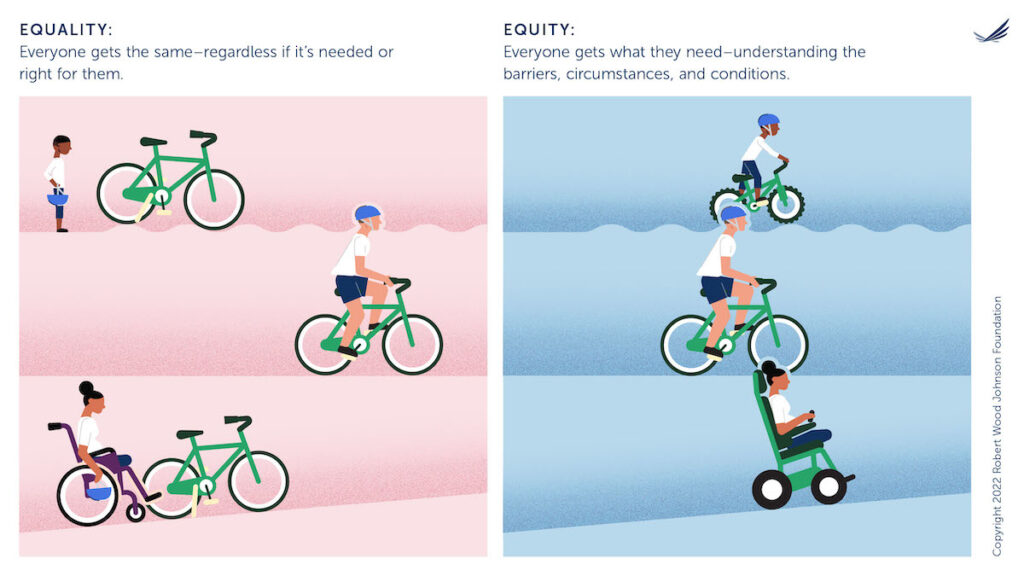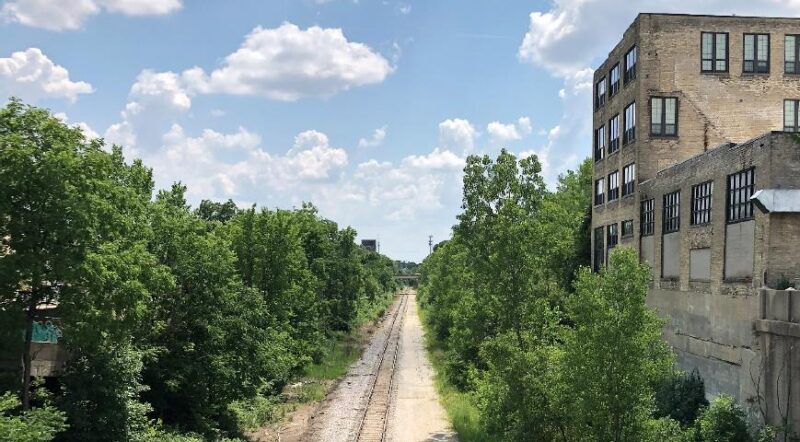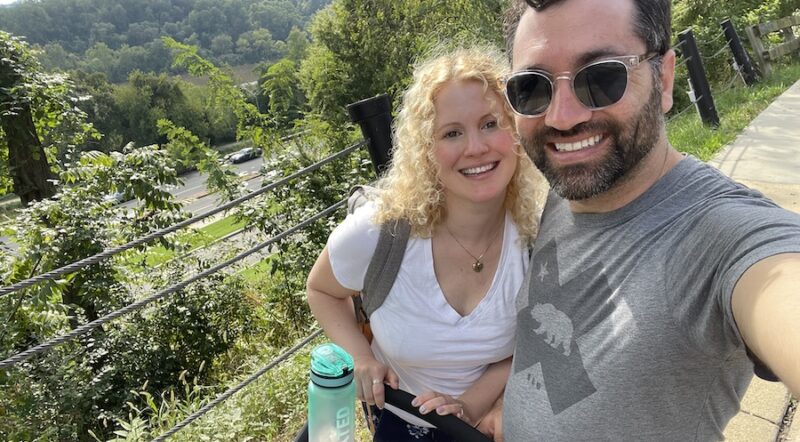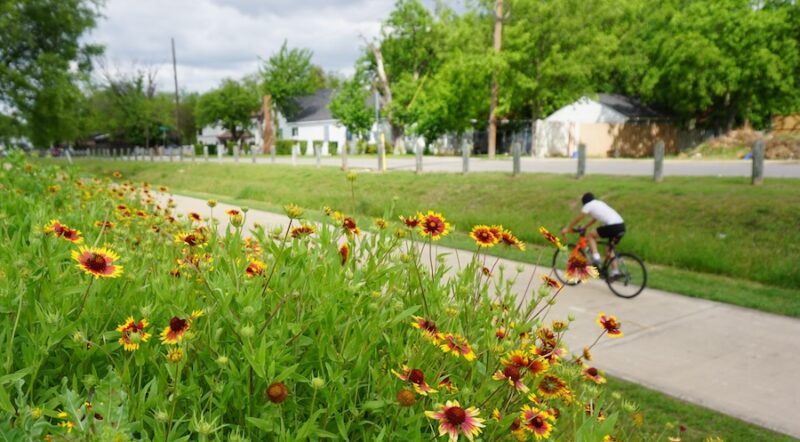Equitable and Inclusive Trails
Black People Who Hike event in August 2023 | Photo courtesy Black People Who Hike
Trails and greenways have the potential to deliver powerful benefits to communities—providing people of every age, ability and socioeconomic background safe and inexpensive spaces for outdoor physical activity, commuting and recreation. Trails can serve as economic catalysts—opening up opportunities for outdoor tourism and small business development, and they can also provide critical “social infrastructure”—public spaces where people can meet, interact and build relationships. Key to maximizing the impact of trails is ensuring every stakeholder in a community is a part of the development process and will benefit from their use.
Historical and Modern-Day Social Inequities
On the surface, trails are egalitarian and inclusive. In practice, these facilities, and the benefits they bring, are not always equitably distributed. Low-income neighborhoods, Communities of Color, people with physical or intellectual disabilities, older adults and people with limited English proficiency are among those that have been traditionally underserved, mis-served or left out of decision-making and planning processes including the development of parks, trails and safe active transportation facilities.
The reasons for these disparities in access and investment are both contemporary and historical. For example, many U.S. cities were intentionally divided along race and class lines—with residential and transportation development patterns rooted in segregation, discriminatory laws and housing policies intended to disadvantage and exclude People of Color. Infrastructure such as railroads and, later, highways reinforced this segregation. As a result, neighborhoods on the “wrong side of the tracks”—mostly low-income, Black neighborhoods and other neighborhoods predominated by People of Color—experienced exclusion, disinvestment, physical barriers and even destruction. Richard Rothstein’s Color of Law and the University of Richmond’s Mapping Inequality project both provide more insight into the history and legacy of America’s discriminatory urban policies.
This separation even extended to outdoor recreation; pools, beaches and municipal parks were segregated both by law and in practice. These places, which ought to have been places where Americans from different walks of life could come together, instead became contested spaces. Non-whites who attempted to defy these color bars were met with resentment, vitriol, threats and even outright violence.
The marginalization of Black Americans and other People of Color has had lingering impacts to this day. Studies show that lower-income and ethnic minority people have access to fewer acres of parks per person and to parks with lower quality, maintenance and safety, than wealthier, White residents. Non-white and lower-income residents are three times more likely to live in ‘nature-deprived’ communities without access to trees, parks and other green space. As a result, formerly redlined urban neighborhoods tend to be hotter than non-redlined neighborhoods, a difference of up to 12 degrees Fahrenheit in some cities, and experience poorer air quality.
All of these things work together to negatively impact the health of residents. Black and Brown Americans experience disproportionately higher rates of chronic illnesses, including asthma, diabetes and obesity. With fewer areas where they can safely walk, People of Color and lower-income residents are more vulnerable to fatal crashes while walking.
In addition, crime and the perception of safety, as well as racial profiling, harassment and stereotyping, has made People of Color feel unwelcome, uncomfortable and even unsafe in the outdoors. Researcher Charles Brown speaks about the concept of “Arrested Mobility”, detailing the ways in which Black communities are over-policed and how this impacts their abilities to move freely and safely.
As cultural geographer and author Carolyn Finney states, “For Black people, navigating both city streets and hiking trails can be charged; at worst, they are fraught terrains where we are at the mercy of someone else’s interpretation of our presence. Too often, by default, Black people are perceived as threats to White people’s physical safety. And as a consequence, it is our physical safety that is compromised.”
Equitable Trail Development and Access

Recognizing these disparities—and making a genuine effort to address them—is the backbone of equity. Equity is not the same as equality: Equality means treating all people the same, but assumes that everyone is starting from the same place and requires the same remedy. Equity recognizes that people have differing needs, and works to promote fairness and provide proportional remedies. In the image above, equality is the equivalent of giving the four different individuals the same exact bicycle, but equity means giving them a bicycle that suits their specific needs.
The overarching idea of equity means meeting people where they are, recognizing disparities and addressing needs. In trail development, equity and inclusion are rooted in empowerment, with the following in mind:
- People have the power to decide whether they want trails, they can access the appropriate resources to do so, and they can actively participate in the planning and programming of those trails. The Richmond Greenway in California is an excellent example of a community-led trail planning process.
- The existing community will benefit from the trails.
- The residents are able to use trails freely and safely.
Trails have the ability to help reconnect long-divided neighborhoods and contribute to healthier and more inclusive communities. For the trails movement to thrive, it is imperative that all stakeholder groups—with a focus on those that have been traditionally underserved—are properly represented at all levels within the movement.
Trail professionals and trail lovers alike can play a role in making trails more inclusive and equitable. This page provides helpful resources and strategies for the advancement of equitable trail development and access across the country.
Internal Equity
Even with the best of intentions, the policies, practices, attitudes and cultural messaging of trail groups and government at all levels may end up at best maintaining the status quo, or at worst exacerbating existing socioeconomic and racial inequalities. Examining these things through an equity lens is the first step to producing more equitable outcomes.
Lack of diversity within the trails, outdoor and active transportation professions demands that professionals government agencies and organizations in this space do their own work to build up their cultural competencies. Cultural competency training is also helpful to equip staff with the knowledge and appropriate messaging needed to reach across socioeconomic, racial and cultural barriers. This type of training can help people confront their internal biases and develop empathy in their work.
- The Interaction Institute for Social Change defines the process of cultural competency as follows:
- Engage in introspection, education and skill-building to build competencies of racial and cultural differences without over-generalizing.
- Unlearn prejudices and biases.
- Appreciate and empathize with those who are different.
- Learn new attitudes, skills and behaviors for personal change and healing.
- Advancing equity also requires questioning the status quo. This includes questioning assumptions about standard planning practices, identifying where they are not working for People of Color, and finding ways to change.
Sometimes, the racial and cultural distance between an organization’s staff and volunteers, and the communities in which they work, can be a barrier to building trust. Government agencies, organizations and coalitions can first address this challenge through building an organizational culture that values equity and works to address it from the inside out. For example, in the Washington, D.C., region, the Capital Trails Coalition—comprising a diverse group of more than 60 public and private organizations, as well as volunteers—has adopted an ethos of Equitable Trail Development, which they use to guide not only their external work but their internal practices and composition as well.
Capital Trails Coalition’s Statement on Equitable Trail Development
The Capital Trails Coalition recognizes long-standing and current societal inequities that have their roots in generations of unjust structural barriers, policies, practices, attitudes, language and cultural messages have disproportionately impacted many minority groups.
Therefore, the Coalition will promote an equitable trails network by analyzing the unique challenges and circumstances impacting specific populations’ mobility, safety and connectivity needs.
The Coalition will use this information to offer and advocate for solutions so that the trail network more effectively serves all residents, including current and potential trail users.
The Coalition will also use this lens proactively to influence its own structure and decision-making framework.
Likewise, we at Rails-to-Trails Conservancy (RTC) have produced our own statement laying out our commitment to equity. The statement reads in part: “we take seriously the responsibility and opportunity to create valued community space that connects people rather than divides and separates people. Our work needs to prioritize grassroots leadership, emphasize introspection and acknowledge historical injustices that continue to negatively impact people’s lives.”
In addition to doing the internal work of building cultural competencies, it is also critical to examine human resource recruitment and pipeline development practices for opportunities to make organizations and government agencies inclusive and representative of the communities you seek to serve—ensuring both proper representation in your leadership and staff and diverse perspectives guiding your work.
- A 2014 study by Green 2.0 (formally the Green Diversity Initiative) showed that racial and ethnic minorities were underrepresented in the workforce of environmental organizations. Based on a survey of 300 nonprofits, government agencies and foundations, the study found that People of Color represented only 12% to 16% of their employees even though they represented 36% of the U.S. population. Green 2.0 produced another report, “Beyond Diversity: A Roadmap to Building an Inclusive Organization,” that discusses good practices for recruitment and retention of a diverse workforce.
- The planning profession faces similar challenges; according to the 2018 American Planning Association’s (APA’s) salary survey, the typical planner is a 42-year-old White male. Only 13% of 6,770 full-time planners who participated in the survey identified as Black, Hispanic or Asian, and 43% identified as female. One reason for this underrepresentation of non-white planners is that there are not enough young People of Color in the academic pipeline into the profession, partly because the profession itself is not well-known or understood, and partly because there have not been intentional efforts to recruit People of Color into the field. The APA has come up with initiatives and resources geared toward increasing diversity, equity and inclusion in the profession, including a DEI Training series and the APA Ambassador outreach program for youth and diverse audiences.
- Initiatives like the Alliance for Watershed Education’s Fellowship Program and the Greening Youth Foundation are working to create a pipeline of talented individuals who are drawn from diverse and underrepresented communities, and who have the potential to become future environmental leaders, by exposing them to environmental education and skills training.
- Local government can benefit from examining their equity practices as well. The Government Alliance on Race and Equity (GARE) is a “national network of government working to achieve racial equity and advance opportunities for all.” GARE, which draws membership from local jurisdictions across the United States, provides tools, resources and training to help local governments take an equity lens to their work.
Definitions
(Adapted from cited sources)
Equity – Equity ensures that individuals are provided the resources they need to have access to the same opportunities as the general population. Equity represents impartiality, i.e. the distribution is made in such a way to even opportunities for all the people. Conversely, equality indicates uniformity, where everything is evenly distributed among people. (University of Washington)
Equality – Equality is the condition under which every individual is treated in the same way and is granted the same rights and responsibilities regardless of their individual differences. (University of Washington)
Inclusion – Inclusion involves authentically bringing traditionally excluded individuals and/or groups into processes, activities and decision/policy making in a way that shares power. (University of Washington)
Diversity – Diversity describes the myriad ways in which people differ, including the psychological, physical and social differences that occur among all individuals, such as race, ethnicity, nationality, socioeconomic status, religion, economic class, education, age, gender, sexual orientation, marital status, mental and physical ability, and learning styles. Diversity is all-inclusive and supportive of the proposition that everyone and every group should be valued. (University of Washington)
Equity Stories
View More Blogs
Federal Grant Boosts Trail Connectivity Within Milwaukee’s 30th Street Corridor: A Model for Collaborative Community Development

Venturing Out on Trails as a New Mom

National Trail Grant Awardees Focus on Youth and Inclusive Signage
Resources
‣ Webinar – Understanding Barriers to Trail Use
‣ Report – Inclusionary Trail Planning Toolkit
‣ Report – Urban Pathways to Healthy Neighborhoods
‣ Fact Sheet – Justice40 Covered USDOT Programs with Match Flexibility
‣ Fact sheet – Glossary of Terms Relating to Equitable Trail Development
TrailNation Collaborative
TrailNation™ Collaborative is a nationwide peer learning community from Rails to Trails Conservancy that brings together advocates, leaders and professionals from across disciplines to establish and accelerate trail networks across America. The collaborative provides proven tools, methods and resources, combined with RTC’s expertise and network of partners across the country, to accelerate the development of connected trail systems. When trails are connected across regions and states, trail networks have a proven transformative impact—they are essential infrastructure that creates thriving, healthier communities.